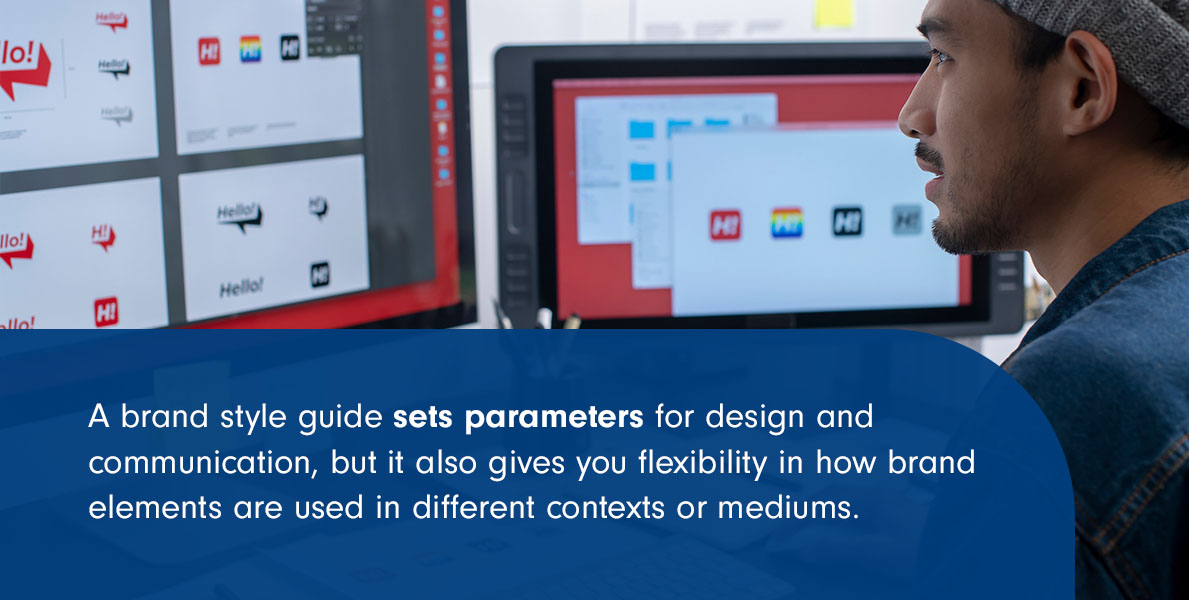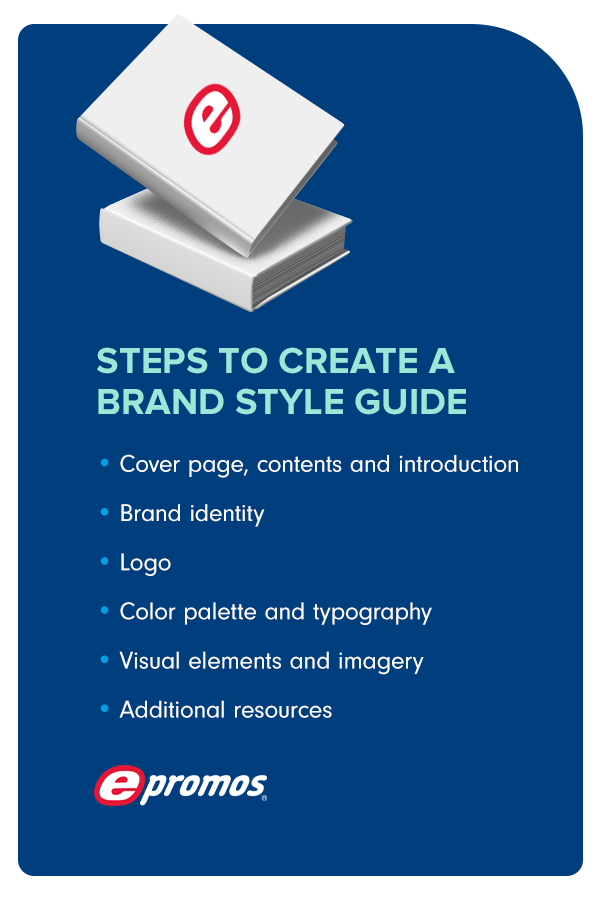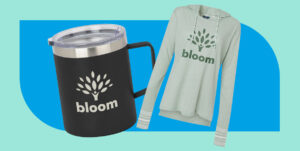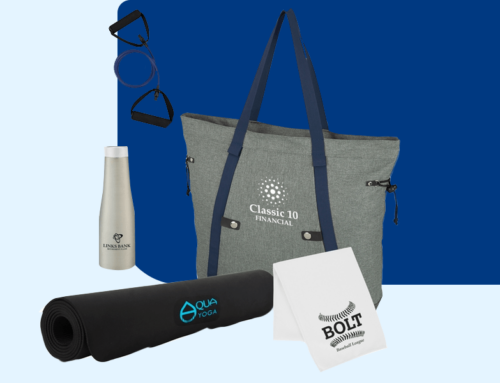05/02/2024
What You Need to Know About Creating a Brand Style Guide
Your brand style guide is the blueprint that ensures consistency and cohesion in how your brand presents itself to the world. It is a comprehensive document outlining the visual and verbal elements that define your business or organization’s identity. It guides style, composition and your brand’s general look and feel. From logos to color palettes, tone of voice and typography — it provides employees and stakeholders with crucial guidelines to maintain a unified brand image across all communication channels.
Find out what key components to include in your visual style guide and explore our practical tips for adjusting this document for your industry. This information will empower you to create a consistent and impactful brand presence.
The Benefits of Brand Guidelines
Your brand style guide is a valuable tool for yourself, employees and stakeholders that helps to maintain a strong brand identity. It gives everyone clarity on how to craft designs and messaging that resonate with your audience and help your brand stand out among competitors. Small businesses with brand guidelines can see up to a 20% revenue increase thanks to consistent brand representation. Additional benefits include:
- Consistency: Consistency helps to build trust and reinforces brand recognition. A brand style guide ensures the visual and verbal elements of your brand are consistent across various platforms.
- Efficiency: Content creators, designers and marketers can streamline their processes when they have clear guidelines to follow for branded materials.
- Brand recognition: Consistency creates a memorable brand identity that consumers will be able to recognize quickly, associating it with your organization’s qualities and values.
- Brand alignment: This document is essentially a reference point for internal teams and external partners to ensure everyone has clarity on your brand’s mission and values. The result is a unified approach to brand communication and integrity.
- Flexibility: A brand style guide sets parameters for design and communication, but it also gives you flexibility in how brand elements are used in different contexts or mediums. This way, your team can adjust your brand design to suit various communication channels while maintaining consistency.

eTip: A brand style guide is not the same as your corporate identity (CI) document. A CI doc focuses on your company’s primary visuals with examples of how this reflects on digital and print formats. The brand style guide may contain this information but is more in-depth, referencing grammar, tone, design and more.
The Core Elements of a Branding Style Guide
Before you start putting together a style guide, there are some variables to confirm and clarify. These components enforce consistency across all of your brand communication, helping maintain that cohesive brand image internally and externally. Add the following core elements to your branding style guide:
- Brand story: Outline the fundamental aspects of your business to give stakeholders a clear understanding of what the brand stands for. Include your brand’s history, code of ethics and values statement. Make a list with three key phrases or words that describe your brand — this will help establish its personality and help copywriters effectively communicate with your target audience.
- Logos: Provide links for all variations of your logo, including how to use each correctly. Specify the rules regarding your logo’s size, placement, spacing and usage on various platforms or on different backgrounds. It is important to clearly state limitations when using your logo, for example, not adding a drop shadow or changing the colorway.
- Color palette: Define your color palette to establish a recognizable brand identity. Include the primary brand colors, secondary colors and any accent colors with their corresponding RGB values, Hex codes and CMYK references for accurate color reproduction.
- Typography: Specify the fonts you use for your branding and which are to use for headings, body text and other typographic elements. Add guidelines for font sizes, weights and spacing, with restrictions where necessary.
- Imagery: Create guidelines for selecting and using imagery or photographs to ensure that all visuals align with your brand’s aesthetic. Include recommendations for image treatments, photo styles and guidelines for using stock photography. If you have any pre-approved images, add a link to that folder with usage guidelines.
- Visual elements: These elements focus on icons, illustrations, patterns and textures that designers may add to collateral. Define the correct way to use these items with placement and customization guides.
- Voice and tone: The tone and voice you use in written messages reflect your brand’s personality and help establish rapport with your target audience. Include guidelines for your brand’s communication style, language choices and messaging principles.
eTip: Collect usage examples of correct and incorrect uses of these elements to showcase your style in action. Consider adding mock-ups of branded materials like business cards, packaging designs and social media posts to give a visual idea of your preferences.
Steps to Create a Brand Style Guide

Creating your brand style guide involves several key steps to ensure you cover all aspects of your visual and verbal identity. If you already have the core elements of this document, you are halfway done. Otherwise, you can create them as you build your brand design guide. Here are the steps to consolidate all the core guidelines into one document:
- Cover page, contents and introduction: Start with a cover page that features your brand’s logo and name with a tagline. Include a table of contents to make it easier for stakeholders to navigate this document. Follow up with an introduction that explains the style guide’s purpose, importance and critical elements to look out for.
- Brand identity: Start by adding your brand’s story, which includes the mission, vision and values. Expanding on this information showcases what sets it apart from competitors and defines your brand’s positioning statement. Add details about your preferred voice and tone, and use descriptive language to convey the essence of your brand.
- Logo: Follow your brand story with the brand’s logo guide, which contains all of the technical information designers will need for marketing collateral, promotional items and more.
- Color palette and typography: Add the color and typography guides. Ensure you include digital, print and physical guidelines for using these elements, as using the wrong font size or color hex value can thwart the appearance of your designs.
- Visual elements and imagery: Explain the use of imagery and visual elements, providing links to resources and existing image banks that designers and stakeholders can use.
- Additional resources: You can add mock-ups for emails, social media posts and letterheads in this section, with supplementary information like legal disclaimers, trademark usage guidelines or brand managers’ contact information. You can also add a buyer persona to help guide blog content, visual media and ad copy.
Once the style guide has final approval, distribute the document to all relevant organizational stakeholders. These may include employees, external partners and contractors. Offering training sessions will ensure everyone understands and will adhere to these guidelines. Remember, this document can be as short or as long as you want it to be as long as it helps stakeholders to keep your brand consistent throughout all communication and designs and keeps everyone on the same page.
eTip: Make an infographic version of your brand’s style guide for quick reference and easy sharing. This ensures everyone in your organization adheres to and thoroughly understands this guide.
Tailoring Your Branding Design Guide for Specific Industries
If you are building a style guide from scratch, it is essential to ensure your brand preferences align with certain industry standards. For example, the target audience of a luxury brand may expect more bold and sleek designs to communicate a level of prestige and exclusivity. Use these tips to ensure your brand’s style better reflects its industry:
- Automotive: Emphasize sleek designs and bold colors to convey movements and technological advancement if your business is in the automotive industry. Adopt a confident, authoritative and performance-driven tone with language that aligns with consumer aspirations or lifestyle preferences.
- Construction: Convey professionalism by using more photos of real people, showing potential clients your capabilities. You can also incorporate rugged textures, safety-focused imagery and authoritative language. Earthy tones and industrial colors like beige, concrete gray or safety orange are good choices as they represent natural minerals and construction materials.
- Healthcare: In healthcare, branding should reflect trust and reliability. Use the calming color psychology of green or blue to convey this message. Incorporate empathetic messaging into your marketing materials with clean and professional design elements. Be compassionate, informative and reassuring with language that addresses patients’ needs and concerns.
- Education: Use dynamic and inspiring design elements to promote creativity, innovation and learning. You can opt for bright colors and playful shapes with images of students and teachers that capture the excitement and the joy of learning. Use a tone that is friendly, inclusive and supportive with language that encourages curiosity.
eTip: In industries like the above, it is vital to be specific, adding details and scenarios for wording or tagline usage. In some cases, it might be worth it to get professional help to ensure your brand design guide is thorough.
The Importance of Adapting Your Brand Guide
It is important to periodically adapt your brand’s style guide, ensuring your brand stays relevant, consistent and effective in communicating its identity to the target audience. These changes are not necessarily large-scale, like a logo revamp or the addition of new colors. It is more about keeping your brand guide up to date, refreshing wording and replacing outdated images. Your brand identity might evolve in response to industry changes, consumer preferences or market trends. This strategy helps you stay competitive, setting you apart from your competitors in your customers’ eyes.
While it is essential to adapt to changes, it is just as important to stay consistent in your brand identity and messaging. Your target audience is likely to stay the same, so keep your focus on engaging customers and meeting their needs, expectations and preferences. This way, you can tailor your visual and verbal elements to resonate more effectively with your customers.

When you adapt your style guide, the extent of these changes will depend on factors like industry trends, market dynamics and the nature of changes in your brand’s identity. Make your adjustments strategically, focusing on areas that need refinements and updates while preserving your brand’s core identity. Conduct thorough research, get feedback from stakeholders and evaluate the potential impact of each change before making the adjustments official.
eTip: Adaptations can only relate to digital use, physical products or social media. Only make changes where it is necessary, and keep track of your brand’s evolution for future reference.
Designing Promotional Products Using Your Brand Style Guide
Promotional products are a great way to introduce your business to new customers and effectively help to remind people about your offering. Up to 78% of consumers agree that promotional products stand out more than advertising efforts. Your brand’s style guide plays a vital role in designing promotional products and helping stakeholders create cohesive and impactful marketing materials.
When designers or third-party service providers understand the specifications for using your logo, color palette, typography, imagery and tone, they can work on designs with potentially minimal changes. By following these steps and leveraging this document effectively, you can design promotional products that communicate your brand’s identity, engage your target audience and drive tangible results for your business:
- Select your promotional products: Choose products that align with your brand’s identity, target audience preferences and marketing objectives. Generally, products that offer versatility and utility, like apparel, bags, drinkware, stationary or tech accessories, always go over well. If sustainability is important to your organization, opt for products that replace single-use items.
- Incorporate brand elements: Identify key brand elements like a specific version of your logo, colors and typography into each type of a promotional product’s design.
- Engaging designs: Instead of adding a simple logo on a cup, try to develop designs that are memorable and visually appealing. Tailor the design to suit the unique characteristics and constraints of the products you choose. Consider the size, shape, material and printing method that will be used to ensure optimal effectiveness and visibility.
- Brand consistency: Your style guide exists to enforce consistency, but it is still vital to check each design and confirm that it reinforces your brand identity, creating a unified brand image.
Design Your Promotional Products With ePromos
Creating a brand style guide is essential to establishing brand recognition, building trust with your audiences and conveying a sense of professionalism and coherence. Whether you are running a startup or a large organization, a clear and well-defined brand style guide will ensure every interaction people or other businesses have with your brand reflects its personality, values and visual identity.
At ePromos, we offer promotional products, business packaging and fulfillment, artwork services and more. Our full suite of services simplifies your job and helps your promotions be more successful. Contact us today for the expertise to make your operations outstanding for 100% guaranteed satisfaction.







